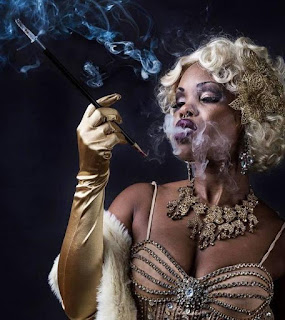A model on the cover of a girly magazine circa 1965 (see more @gemma_parker_artist)
In this third post exploring the history of the black Pin Up I'm going to be looking at the classic Pin Up model. The girl commonly referred to as 'cheesecake'.
In this third post exploring the history of the black Pin Up I'm going to be looking at the classic Pin Up model. The girl commonly referred to as 'cheesecake'.
She's flirty and sexy but never overtly so and her brand of sex is only just PG by today's standards, but in her time (the golden years falling between 1930's-1960's) the Pin Up was as sexy as you could get without going 'under the counter'.
Girly magazines were the place to find pin ups and as American culture then, as now, was predominantly white it follows that so was the Pin Up. However, publishers soon caught on that there was a huge untapped market for black bombshells. Yes, black models occasionally appeared in mainstream white publications, but it was rare, and they were often typecast into the well used (and previously discussed) widely acceptable ideas of the 'Savage woman'.
Alongside the issues of 'Flirt' 'Wink' and 'Beauty Parade' came magazines that catered to African-American readers like 'Jive' 'Sepia' and 'Ebony'. Before we even take a look at the pin ups in these publications it's interesting to note the titles. Unlike the publications targeted at the white American male which made sideways references to the girly pictures inside, the black counterparts use entirely black references, not only setting them apart but also claiming those descriptive words for themselves. 'Jet' Magazine may be one exception to this rule because although appearing to make use of the colour black in it's title, it's founder John J Johnson stated that it was called Jet because, "In the world today everything is moving along at a faster clip. There is more news and far less time to read it."
It's also evident that 'Jet' took on some weightier issues regarding race than the typical girly mag. During it's early years the magazine covered the Civil Rights Movement and Martin Luther King and tackled ideas that affected the African-American population of the time.
The Pin Ups in the magazines had a different portrayal too. Instead of play acting and goofing around with black stereotypes they posed as straight forward pin up models, women who were celebrated for their beauty, not the titillating idea associated with the colour of their skin.
After the revolution of Playboy magazine in 1953 there was a gap for a more up market and intellectual 'mens' magazine aimed at the African-American male. Along came 'Duke Magazine'. First published in 1957 Duke's centrefolds were called 'Duchess of the month' and elevated the model from girl next door to goddess.
Compare this image with the previous photo above of Evelyn Pitcher doing her 'Devil dance' and its clear that this Pin Up's sexual allure is being taken seriously. It is a sad yet interesting fact that the black Pin Up was mostly only seen as a real woman with real sensuality by her black audience
Moving forward to modern times, the Pin Up is here to stay. The vintage Pin Up aesthetic wavered during the 70's through to the 90's, then somewhere around the early 2000's she made a come back. With burlesque nights and vintage fairs now a regular occurrence, where is the black Pin Up now?
She's alive and well in contemporary music videos, and in a twist of post modernism you can find Beyonce morphing into Bettie Page in her video for 'Why Don't You Love Me'. It stands out to me that things seem to have gone full circle in this instance. In my first post in this series I talked about how the mainstream white pin up would sometimes appropriate the garb of another culture, yet the true pin ups from those cultures remained unseen. Here, Beyonce dons the garb of a popular white pin up as if she is just another trend to play with.
Also unlike previous black performers and models, who took on a racial stereotype which hid their true identity, with Beyonce her donning of a white cultural stereotype only serves to enrich and empower her individuality.
Beyonce is in the lucky position to do all this thanks to her black Pin Up siblings from the past who paved the rocky and uneven path that helped lead to the modern image of a strong powerful black woman. Thanks to their struggles and hard work she can now claim to be 'Queen B' and have the freedom own her sexuality and project it in any way she chooses.
Also unlike previous black performers and models, who took on a racial stereotype which hid their true identity, with Beyonce her donning of a white cultural stereotype only serves to enrich and empower her individuality.
Beyonce is in the lucky position to do all this thanks to her black Pin Up siblings from the past who paved the rocky and uneven path that helped lead to the modern image of a strong powerful black woman. Thanks to their struggles and hard work she can now claim to be 'Queen B' and have the freedom own her sexuality and project it in any way she chooses.
-
Before I end this post, I'd like to mention here some of the fabulous modern black Pin Ups who work in the industry and take inspiration from the past. These are all gorgeous women who claim their black heritage and the Pin Up aesthetic to create beautiful images and performances.
Angelique Noire
Perle Noire
Jeez Loueez
Kristina Paulk
...and there are MANY more!
Join me next time when I take a look and the world of Pin Up illustrations and how the black Pin Up features...or does she?
















No comments:
Post a Comment